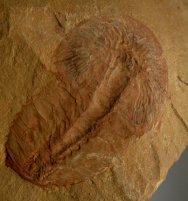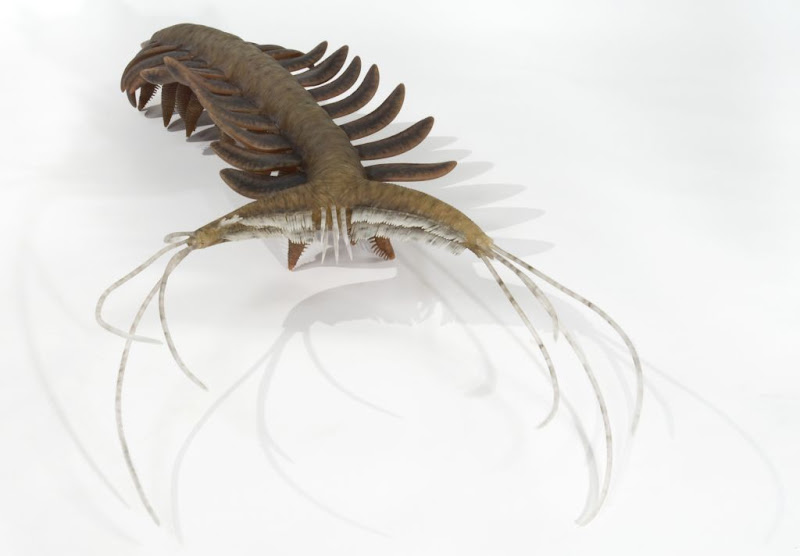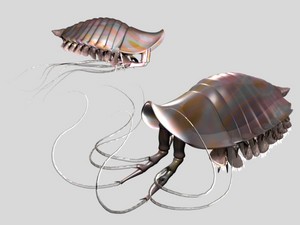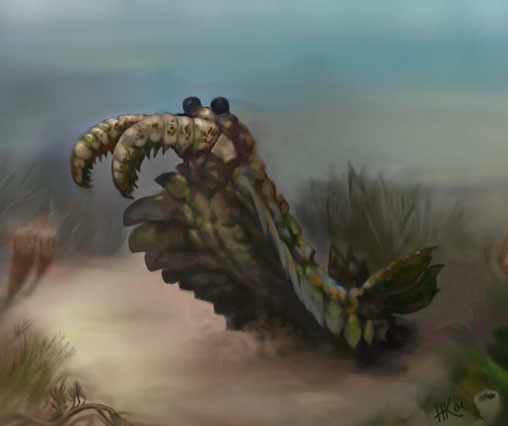[Recent Entries][Archive][Friends][User Info]
August 6th, 2011
| August 6th, 2011 | |
|---|---|
| 12:00 pm [industrialterro] [Link] |
Yohoia Yohoia is a tiny, extinct animal from the Cambrian period that has been found as fossils in the Burgess Shale formation of British Columbia, Canada. It has been placed among the arachnomorphs, a group of arthropods that includes the chelicerates and trilobites. Their sizes range from 7 to 23 mm. 711 specimens of Yohoia are known from the Greater Phyllopod bed, where they comprise 1.35% of the community. Specimens of Yohoia have a head shield which is followed by 13 trunk tergites, or plates. On both sides, the bottom side of the first 10 of these ended in backward-pointing, triangular points or projections. The last three plates were complete tubes, circling the entire trunk. At the end of the trunk was a paddle-like tail. There were also a pair of large extensions at the front of the head shield. They had a pronounced "elbow" and ended in four long spines, looking rather like fingers. There were three appendages on the bottom of the head shield on each side, and these are assumed to have supported the creature on the sandy or silty sea bottom. There were also single appendages hanging down under the body plates which were flap-like and fringed with setae, probably used for swimming and respiration. Specimens also show some bulbous formations at the front of the head shield that may have served as eyes.
Tags: Вымершие членистоногие, Кембрий |
| Time | Event |
| 12:08 pm [industrialterro] [Link] |
Waptia Waptia fieldensis was a small, shrimp-like stem group crustacean. Many Cambrian crustaceomorphs such as Waptia lack the mouthparts to be classified as crown group crustaceans that lived during the Middle Cambrian about 510 million years ago. 454 specimens of Waptia are known from the Greater Phyllopod bed, where they comprise 0.86% of the community. Waptia-like arthropods discovered in the Chengjiang form chains of up to 20 individuals, with each animal's tail nested in the carapace of the one behind. These chains must have been rigid to be preserved.
Tags: Вымершие членистоногие, Кембрий |
| Time | Event |
| 12:22 pm [industrialterro] [Link] |
Naraoia Naraoia is a genus of trilobites (or trilobite-like arthropods) found in Cambrian strata of the Burgess Shale and the Maotianshan shales Lagerstätte. They were flattened, oval-shaped animals, with an uncalcified shield that was divided into two regions, a smaller region covering the head, and a larger section covering the body. There are no hint of lobes, as in true trilobites. All species were blind, showing no trace of eyes. Naraoia fossils range between 2 and 4 centimetres in length. 392 specimens of Naraoia are known from the Greater Phyllopod bed, where they comprise 0.74% of the community.
Tags: Вымершие членистоногие, Кембрий |
| Time | Event |
| 12:33 pm [industrialterro] [Link] |
Halkieria Halkieria (pronounced /hælˈkɪəriə/) is a genus of fossil organisms from the Lower to Middle Cambrian. It has been found on almost every continent in Lower to Mid Cambrian deposits, forming a large component of the small shelly fossil assemblages. The animals looked like slugs in chain mail - 1.5 centimetres (0.59 in) to 8 centimetres (3.1 in) long, bilaterally symmetric, flattened from top to bottom and unarmored on the bottom. Very near each end there is a shell plate with prominent growth lines rather like the growth rings of trees. The rest of the upper surface was covered with about 2,000 sclerites that overlapped each other like tiles and formed three zones with sclerites of different shapes: "palmates", shaped rather like maple leaves, ran along the center of the back between the shell plates; blade-shaped "cultrates" lay on either side of the palmates and pointing towards the middle of the upper surface; and slim, sickle-shaped "siculates" covered the outer edges. As the animals grew, the shell plates grew by adding material to the outer edges. Individual sclerites stayed the same size; since the cultrate sclerites form a pattern that is constant in all fairly complete specimens, the old ones that were too small may have been shed and replaced by larger ones as the animals grew. There are traces of thin ribs between the sclerites and the skin.
Tags: Вымершие беспозвоночные, Кембрий |
| Time | Event |
| 12:43 pm [industrialterro] [Link] |
Pambdelurion Pambdelurion whittingtoni was a blind nektonic organism from the Sirius Passet Lagerstätte, from Cambrian Greenland. Its anatomy strongly suggests that it, along with its relative Kerygmachela kierkegaardi, was either an anomalocarid or a close relative thereof. P. whittingtoni had a pair of massive anterior limbs that corresponded to the feeding limbs of other anomalocarids. The anterior limbs had a row of flexible, hair-like spines that corresponded with each segment of each limb. Unlike K. kierkegaardi, P. whittingtoni's mouth was relatively large, though it does not appear to have any large biting surfaces like the mouth of Anomalocaris. It had 11 pairs of lateral lobes, and 11 pairs of relatively large, lobopod-like legs. None of the fossil specimens have any suggestion of posterior cerci, or tail-flaps. The massive anterior limbs, with their comb-like rows of spines, suggest that P. whittingtoni was a planktivore.
Tags: Вымершие членистоногие, Кембрий |
| Time | Event |
| 12:50 pm [industrialterro] [Link] |
Kerygmachela Kerygmachela kierkegaardi was a blind nektonic organism from the Sirius Passet Lagerstätte, from Cambrian Greenland. Its anatomy strongly suggests that it, along with its relative Pambdelurion whittingtoni, was either an anomalocarid or a close relative thereof. The specific name, "kierkegaardi" honors Danish philosopher Søren Kierkegaard. It had a pair of well-developed anterior limbs that had long spines, and terminated in long, feeler-like cerci. These limbs correspond to the traditional anterior feeding-limbs of other anomalocarids. The conical mouth opens up at the very base between these two limbs. It also had 11 pairs of lateral lobes (used in swimming), along with 11 pairs of small legs at the lobes' bases, and a posterior pair of cerci. The spiny anterior limbs suggest that it may have been a predator; however, its small mouth suggests it would have been restricted to very small prey.
Tags: Вымершие членистоногие, Кембрий |
| Time | Event |
| 01:00 pm [industrialterro] [Link] |
Orthrozanclus Orthrozanclus reburrus ("Dawn scythe with bristling hair") is a sea creature known from the Middle Cambrian (~505 million years ago) Burgess shale, about one centimeter long, with long spikes protruding from its armored body. The describers of this fossil animal, Simon Conway Morris and Jean-Bernard Caron, say Orthrozanclus may have formed a link between the halkieriid and the wiwaxiid families, uniting them tentatively in a group called "Halwaxiida", characterized by a similar type of body armor; these organisms might have been stem group molluscs, or fall as a stem group to the larger lophotrochozoan clade (containing molluscs, annelids and brachiopods). However, the status of the Halwaxiid grouping is not universally accepted.
Tags: Вымершие беспозвоночные, Кембрий |
| Time | Event |
| 01:09 pm [industrialterro] [Link] |
Odontogriphus Odontogriphus (literally "toothed riddle") is a genus of soft-bodied animals known from middle Cambrian Lagerstätte. Reaching as much as 12.5 centimetres (4.9 in) in length, Odontogriphus is a flat, oval bilaterian which apparently had a single muscular foot, and a "shell" on its back that was moderately rigid but of a material unsuited to fossilization. Odontogriphus was apparently a very rare species, accounting for less than 0.5% of the individual organisms found in the same fossil beds. Most of the fossils consist of two parts of a split block of rock, the upper part giving a "casting" of the animal's upper surface and the lower giving one of its underside. Odontogriphus was a flat-bodied animal ranging from 3.3 millimetres (0.13 in) to 125 millimetres (4.9 in) in length, with parallel sides and semi-circular ends. The specimens examined by Caron, Scheltema et al. (2006) had the same ratio of length to width irrespective of size. The body outlines are bilaterally symmetrical in all fairly complete specimens, even those in which internal features were preserved asymmetrically. Caron, Scheltema et al. (2006) interpreted this as evidence that the animals had on their backs "shells" that were rigid enough to resist whatever stresses distorted the internal features, but were not tough enough to be preserved by fossilization – similar, for example, to finger nails. Relatively broad wrinkles, parallel to each other and usually straight, run across the central region of the body in some specimens.
Tags: Вымершие беспозвоночные, Кембрий |
| Time | Event |
| 01:24 pm [industrialterro] [Link] |
Нектокарис Нектокарис (Nectocaris pteryx) — вымершее кембрийское животное неясного систематического положения. Нектокарисы имели черты схожести с такими разными животными, как Членистоногие, Хордовые, Головоногие Моллюски. Впервые животное было открыто палеонтологами в 1910 году среди первых находок из знаменитого теперь местонахождения кембрийской фауны в сланцах Берджес (Burgess Shale) в Канаде. Канадские палеонтологи Мартин Смит (Martin Smith) и Жан-Бернард Кэрон (Jean-Bernard Caron) из Университета Торонто (University of Toronto) и Королевского музея Онтарио (Royal Ontario Museum) опубликовали в майском номере журнала Nature статью в которой доказывают, что Nectocaridae — предки Головоногих. Они считают, что у нектокариса например был сифон, через который животное могло с силой выбрасывать воду из внутренней полости тела, как это делают современные цефалоподы. Другие учёные считают нектокариса членистоногим. Животное достигало 2—5 см длины, имело 2 щупальца, стебельчатые глаза, «плавники» по бокам тела, и вело хищный образ жизни. Жили в Кембрийский период.
Tags: Вымершие беспозвоночные, Кембрий |
| Time | Event |
| 03:43 pm [industrialterro] [Link] |
Opabinia Opabinia is an animal genus found in Cambrian fossil deposits. Its sole species, Opabinia regalis, is known from the Middle Cambrian Burgess Shale of British Columbia, Canada. Fewer than twenty good specimens have been described; 3 specimens of Opabinia are known from the Greater Phyllopod bed, where they comprise less than 0.1% of the community. Opabinia was a soft-bodied animal of modest size, and its segmented body had lobes along the sides and a fan-shaped tail. The head shows unusual features: five eyes, a mouth under the head and facing backwards, and a proboscis that probably passed food to the mouth. Opabinia probably lived on the seafloor, using the proboscis to seek out small, soft food. Opabinia looks so strange that the audience at the first presentation of Whittington's analysis laughed.The length of Opabinia regalis from head to tail ranged between 4 centimetres (1.6 in) and 7 centimetres (2.8 in). The animal also had a hollow proboscis, whose total length was about one third of the body's and which projected down from under the head and then curved forwards and upwards. The proboscis was striated like a vacuum cleaner's hose and probably flexible, and it ended with a claw-like structure whose inner edges bore spines that projected inwards and forwards. The head bore five eyes: two on stalks near the front and fairly close to the middle of the head, pointing upwards and forwards; two larger eyes, also stalked, near the rear and outer edges of the head, pointing upwards and sideways; and a single eye with a shorter stalk between the larger pair of stalked eyes, pointing upwards. It has been assumed that the eyes were all compound, like arthropods' lateral eyes, but this reconstruction, which is not backed up by any evidence, is "somewhat fanciful". The mouth was under the head, behind the proboscis, and pointed backwards, so that the digestive tract formed a U-bend on its way towards the rear of the animal. The proboscis appeared sufficiently long and flexible to reach the mouth.
Tags: Вымершие членистоногие, Кембрий |
| Time | Event |
| 03:48 pm [industrialterro] [Link] |
Aysheaia Aysheaia was a genus of soft-bodied, caterpillar-shaped organisms average body length of 1–6 cm. The genus name commemorates a mountain peak named "Ayesha" due north of the Wapta Glacier. This peak was originally named Aysha in the 1904 maps of the region, and was re-named Ayesha after the heroine of Rider Haggard's 1887 novel She. They are known from fossils found in the middle Cambrian Burgess shale of British Columbia, and from the Wheeler Formation in Utah. Similar forms are known from the lower Cambrian Maotianshan shales of China. Aysheaia has ten body segments, each of which has a pair of spiked, annulated legs. The animal is segmented, and looks somewhat like a bloated caterpillar with a few spines added on — including six finger-like projections around the mouth and two grasping legs on the "head." Based on its association with sponge remains, it is believed that Aysheaia was a sponge grazer and may have protected itself from predators by seeking refuge within sponge colonies. Aysheaia probably used its claws to cling to the sponge. Unlike many early Cambrian forms whose relationships are obscure and puzzling, Aysheaia is remarkably similar to a modern phylum, the Onychophora. Other than the 20 specimens from the Greater Phyllopod bed, where they comprise 2% of the community, only 19 specimens of A. pedunculata are known. A. prolata is the species from the Wheeler Formation.
Tags: Вымершие беспозвоночные, Кембрий |
| Time | Event |
| 04:03 pm [industrialterro] [Link] |
Sanctacaris Sanctacaris is a Middle Cambrian arthropod from the Burgess Shale of British Columbia. It was most famously regarded as a primitive chelicerate, a group which includes spiders and scorpions, although subsequent phylogenetic studies have not always supported this conclusion; it is best accommodated in the arachnate clade (i.e. as a stem-group chelicerate). Sanctacaris specimens range from 46 to 93 mm in length. The head bears five pairs of grasping appendages and a sixth pair of large separate appendages. The grasping appendages each bear a short antenna-like second appendage. There are 11 body segments, each with a pair of walking legs and gills. There is a broad, flat paddle-like telson.
Tags: Вымершие членистоногие, Кембрий |
| Time | Event |
| 04:19 pm [industrialterro] [Link] |
Leanchoilia Leanchoilia is a four-eyed arachnomorph arthropod known from the Cambrian Burgess shale. It was about 5cm long and had long, whip-like feelers mounted on frontal arm-like appendages. Its guts are sometimes preserved in three dimensions. Leancholia is found in the Burgess Shale in Canada. Two species are tentatively accepted today: the type species L. superlata and the recently-revalidated L. persephone. They may however be examples of sexual dimorphism. 55 specimens of Leanchoilia are known from the Greater Phyllopod bed, where they comprise 0.1% of the community.
Tags: Вымершие членистоногие, Кембрий |
| Time | Event |
| 04:32 pm [industrialterro] [Link] |
Sidneyia Sidneyia is an extinct arthropod known from fossils found in the Cambrian-age Burgess Shale formation of British Columbia. 144 specimens of Sidneyia are known from the Greater Phyllopod bed, where they comprise 0.27% of the community. Sidneyia ranged from 2 to 5 inches (51 to 130 mm) in length and is one of the largest arthropods found at the site. It is thought to have been a benthic carnivore that walked along the sea floor in search of hard-shelled prey. Gut contents have revealed that Sidneyia fed on hyolithids (molluscs) and other small crustaceans and trilobites.
Tags: Вымершие членистоногие, Кембрий |
| Time | Event |
| 04:42 pm [industrialterro] [Link] |
Аномалокарис Аномалокарис ( Anomalocaris — «необычная креветка», русское название не устоялось: встречается аномалокар) — ископаемый род аномалокаридов — животных кембрия надтипа Lobopodia, примитивных родственников членистоногих. Обитали в морях, использовали для плавания гибкие лопасти, растущие по бокам. Для своего времени аномалокарис был гигантским существом размером от 60 см до 2 м. Обитал на территории Северной Америки, Китая и Австралии 535-520 млн. лет назад. В последние годы выяснилось, что аномалокарис был не единственным представителем в своей необычной группе крупных раннепалеозойских членистоногих, выделенных теперь в семейство Anomalocarididae. Одновременно с ним в морях обитала Hurdia victoria, а один из родственников аномалокариса, шиндерханнес (Schinderhannes bartelsi) дожил даже до девонского периода. История открытия самого аномалокариса весьма любопытна – долгое время разные части его тела относили к разным животным, а ротовой диск и вовсе считали отпечатком медузы. Вопрос питания остаётся спорным.
Очевидно, по поводу хвоста также существуют разногласия:
Tags: Вымершие членистоногие, Кембрий |
| Previous Day | 2011/08/06 [Archive] |
Next Day |



































